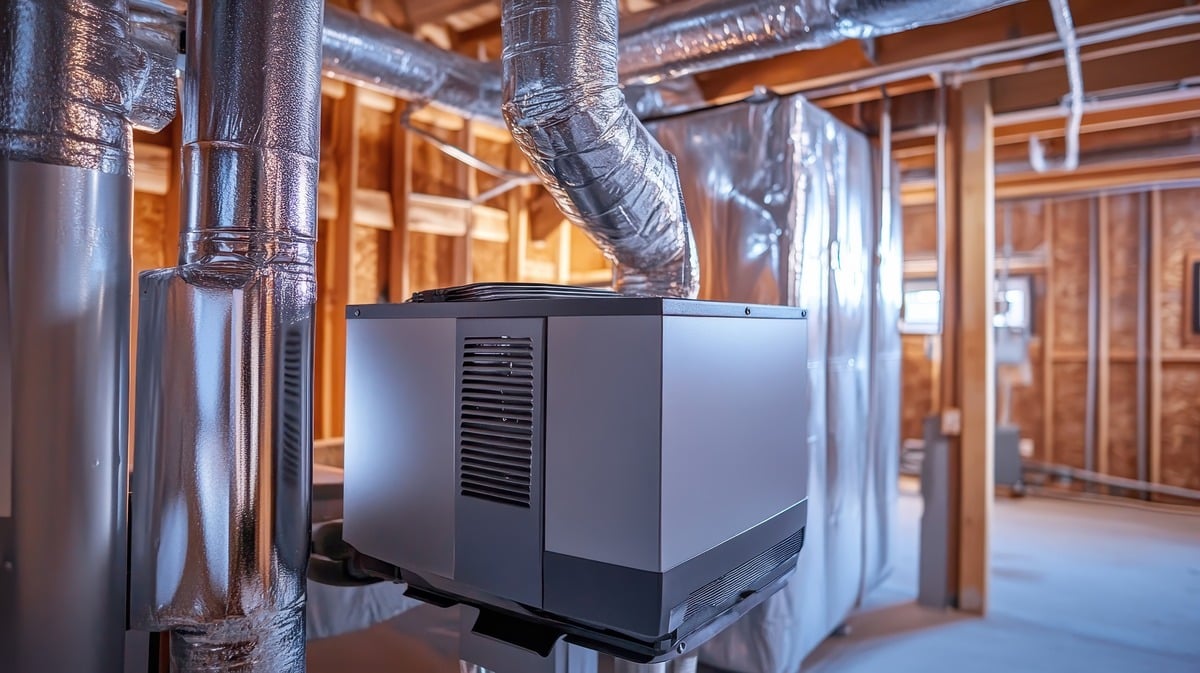
Not sure what settings to use for your dehumidifier? Or maybe you’re wondering where to place it for the best results, or whether a basement dehumidifier can improve the air quality in your whole house. Getting the humidity levels in your basement right can help you avoid mold, mildew, musty smells, and even long-term damage to your home. It’s especially important in moisture-prone areas like basements, crawl spaces, and garages.
Why Humidity Control Matters?
Humidity plays a major role in how your home feels and how well it holds up over time. When moisture levels are too high or too low, it can lead to a variety of problems, from mold growth to dry skin. This is why having a dehumidifier is one of the most important tools for keeping your space safe and breathable.
Effects of High Humidity
High humidity makes your home feel damp and sticky. It can cause mold, mildew, and musty smells, especially in basements and crawl spaces. Over time, it may damage your walls, floors, and furniture, and lead to more dust mites and allergens in the air.
Effects of Low Humidity
Dry air can make your skin itchy and your throat and eyes feel sore. It can also cause static electricity and make it harder to breathe, especially in winter. Over time, it may cause cracks in wooden floors, furniture, and window frames.
Ideal Humidity Range for Most Spaces Recommended by Experts
Experts agree that maintaining the right humidity level is key to a healthy and comfortable home environment; here’s the range you should aim for.
- 30% to 50%: Experts say indoor humidity should stay between 30% and 50%. This helps your home feel comfortable and prevents mold, mildew, and damage.
- 40% to 60%: In some places or seasons, it’s okay if the humidity is between 40% and 60%. This range works when a little extra moisture is hard to avoid.
- The EPA and HVAC experts say indoor humidity should be between 30% and 50%. This range keeps you comfortable, healthy, and protects your home. At the very least, it’s important to keep humidity below 60% to stop mold and keep your home feeling good all year.
Best Humidity Setting by Room Type
Different areas of your home have different humidity needs; here’s how to set your dehumidifier based on the space and its purpose.
Living Areas (Bedrooms, Living Rooms, etc.)
For a comfortable and healthy environment, keep humidity between 40% and 50%. This range helps improve air quality, makes the space easier to breathe in, and reduces allergens like dust mites.
Basements
Basements are often damp, so keep the humidity between 30% and 50%. Lower levels help stop mold, mildew, and damage to your walls and floors.
Crawl Spaces
Crawl spaces hold moisture easily, so keep humidity below 50% to prevent damage. A vapor barrier and dehumidifier work best to keep the area dry.
Garages or Workshops
Set the humidity between 40% and 55% to stop rust and protect your tools and stored items. You may need to adjust it with the seasons, depending on your weather and garage insulation.
Commercial Spaces or Warehouses
Keep humidity between 30% and 60% in commercial and storage areas. Some items may need stricter control, so adjust based on what you store and how the space is built.
How to Measure and Adjust Humidity?
Knowing how to check and control indoor humidity is important for a healthy, comfortable home. Here’s how to measure humidity and set your dehumidifier the right way.
Using a Hygrometer or Built-In Sensor
A digital hygrometer shows the current humidity in your room. Many dehumidifiers have built-in sensors that adjust settings automatically. For the best reading, put the hygrometer at chest height in the middle of the room. This helps you control humidity and set your dehumidifier just right.
Setting Your Dehumidifier
Use the control panel to choose your ideal humidity level. Starting around 45% is a good rule of thumb for basements and crawl spaces. Most dehumidifiers let you adjust in small steps, so you can find what works best to keep your space dry and comfortable.
Factors That Affect Ideal Humidity Settings
Several key factors influence the best humidity level for your space, including climate, home construction, and the size of your dehumidifier.
Climate and Seasonality
Humidity levels are generally higher in warm, wet months and lower in cold months. In humid places, your dehumidifier may need to run more to keep the humidity below 50%. Adjusting it with the seasons helps keep your home comfortable.
Home Insulation and Ventilation
A well-insulated home with good airflow helps keep humidity steady in your home. On the other hand, poor insulation or ventilation can trap moisture, especially in basements and crawl spaces, causing problems. Proper ventilation lowers humidity and helps your dehumidifier work better.
Size and Capacity of the Dehumidifier
Choosing the right size dehumidifier helps remove moisture better. Small units may not work well in big or damp areas like basements. Make sure the dehumidifier’s capacity matches your space and how wet it is.
Signs Your Dehumidifier Is Set Incorrectly
Not sure if your dehumidifier is working the way it should? Here are common signs that your settings may need adjustment.
It Runs Constantly Without Reducing Humidity
If your dehumidifier runs all the time but the air still feels damp, it could be too small for the space or set too low to reach the target. You could also have air leaks or poor ventilation. Adjust the setting, check your space, and make sure the unit is the right size for the job.
The Room Feels Dry or You See Static Buildup
If the air feels dry or you get static shocks, the humidity might be too low. Dry air can also irritate your skin. Try raising the humidity to between 40% and 50% to keep the room comfortable.
Mold or Condensation Appears Despite Usage
If you see moisture on windows or mold on walls, the humidity is still too high. Lower the setting, check for leaks, and think about using a bigger dehumidifier if needed.
Tips for Maintaining Ideal Humidity Levels
Keeping humidity at the right level takes more than just setting your dehumidifier; these simple tips can help you maintain balanced moisture levels in your home year-round.
Clean the Filter Regularly
A dirty filter blocks airflow and makes your dehumidifier less effective. Clean or replace the filter every few weeks to keep it working well.
Monitor Humidity with a Secondary Hygrometer
Even if your dehumidifier has a sensor, using a separate hygrometer may give a more accurate humidity reading. This helps, especially in basements or big rooms, to make sure your dehumidifier is working right.
Use Fans or Ventilation to Assist Airflow
Using fans or ventilation moves air around and stops moisture from building up in certain spots. In basements and crawl spaces, better airflow helps reduce dampness and makes your dehumidifier work better.
Seal Leaks and Insulate Properly
Fix any cracks or leaks in your foundation, windows, or ducts to keep moisture out. Proper insulation helps control humidity and makes it easier for your dehumidifier to do its job.
FAQs
What humidity level is too low for a home?
If the humidity drops below 30%, the air can get too dry. This can lead to dry skin, breathing problems, static shocks, and damage to wood or electronics. Try to keep it above 30% to stay comfortable and protect your home.
Can you run a dehumidifier 24/7?
Yes, you can run a dehumidifier all day and night. Most are made for continuous use. Just keep it clean, empty the water tank often or use a drain hose, and use auto mode or a timer to save energy.
Should I adjust the humidity settings at night?
You don’t usually need to change the humidity setting at night; most dehumidifiers keep things steady. But if the air feels too dry, you can raise the setting a little to stay comfortable.
How long does it take to dehumidify a room?
The time it takes to dehumidify a room depends on its size and the level of humidity. While results can vary, running your dehumidifier consistently will steadily lower humidity and help keep your space comfortable and dry.
Can dehumidifiers help with allergies or asthma?
Yes, dehumidifiers help with allergies and asthma. By lowering moisture, they reduce dust mites, mold, and mildew, making the air easier to breathe.










